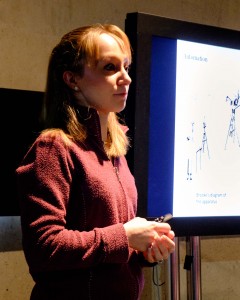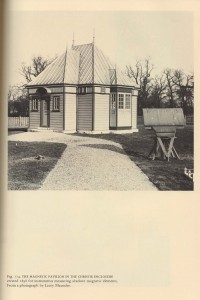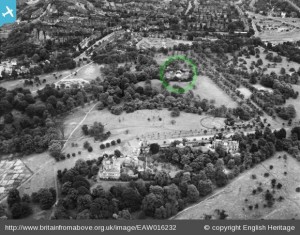February 24, 2015
Mag and Met – History of Astronomy Group Meeting
Louise Devoy
Report by: Mike Meynell
Looking around the galleries at the Royal Observatory Greenwich today, you’d be forgiven for not knowing about the work of the Magnetic and Meteorological departments in Greenwich. Understandably, the focus of the galleries is on the determination of time and the contribution of the Royal Observatory to positional astronomy in order to assist navigation.
The Magnetic and Meteorological departments were not part of the original remit of the observatory. It was George Airy, when he was appointed Astronomer Royal, who recognised the importance of research in this area, not just to assist in navigation, but also to contribute to new developments in science. From 1837 to 1925, a great deal of research and measurement took place in Greenwich. Louise Devoy, the Curator of the Royal Observatory, kindly gave the Flamsteed History of Astronomy group a fascinating summary of the work of the “Mag and Met” department.
Magnetism is essential for navigation, even today with our increased reliance on satellite navigation. The compass is one of the oldest instruments used for navigation. However, even far back as the 15th century, it was noticed that the magnetic compass does not accurately point to true north, but is at an angle to true north that varies depending on your geographical location.
It was William Gilbert in 1600 who first postulated that the Earth was itself magnetic and that was why compasses pointed north. He also argued that the centre of the Earth was iron and recognised that magnetism must act over a distance.
In the 1690’s, Edmond Halley (before he became Astronomer Royal) persuaded the government to pay for two voyages across the Atlantic to measure and map magnetic variation at sea – the “declination” or angle between magnetic and geographic north in a horizontal plane. Halley thought that variations in declination might offer a way to determine a ship’s longitude at sea. However, if one looks at the isogonic chart that Halley produced from these voyages, the contour lines of magnetic variation are very widely spread, meaning that it couldn’t be used to accurately determine longitude.
Louise then took us forward to the 1830s, when Carl Friedrich Gauss and Wilhelm Eduard Weber set up a programme of magnetic measurements in Göttingen, Germany. Gauss and Weber also did work on electromagnetic induction, sending one of the first telegraph signals. Gauss and Weber were keen on setting up an international network of magnetic observatories. Gauss and George Airy had shared correspondence, and Airy concluded that a magnetic observatory should be set up in Greenwich, particularly as ships were now being made of iron instead of wood and it was becoming increasingly important to understand compass variations from both natural and man-made sources. Airy hired James Glaisher to supervise the taking of these measurements.
A new Magnet House was constructed in the south part of the observatory in 1837, close to the area where the Planetarium dome is situated nowadays. The Magnet House contained instruments made in both London and Göttingen, with measurements taken every two hours (except on a Sunday!). Gauss provided information on how certain instruments should be made, so that consistent measurements could be taken. A 24-metre high mast was installed in order to take measurements of atmospheric electricity.
The workload of taking all of these measurements must have been huge, particularly as only three assistants were working on these measurements for the first few years. More assistants were hired later, much to everyone’s relief no doubt. Airy also tried to automate some of these measurements. Charles Brooke, a London surgeon no less, came up with the idea of a photographic recording device to track variations in the Earth’s magnetic field.
Magnetic offices had to be built to house the vast amount of records that were being generated by these measurements. Louise showed us a lovely photograph of what looked like a glorified garden shed, but emblazoned on the side of the shed are the grand words “Depot for Publications of the Royal Observatory”. Wonderful.
Louise also highlighted the work of the Kew Observatory. Kew did a great deal of work in defining standards for chronometers, magnetographs and magnetometers. The links between Greenwich and Kew are not well researched, so Louise was happy to tell us that a researcher will be working with the ROG later this year on this very topic. We look forward to hearing the results of this research.
Louise then described some of the meteorological instruments in use at the Royal Observatory. These included a sunshine recorder, rain gauges, anemometers for measuring wind speed & direction and thermometers sunk at various depths below the surface of the ground. These thermometers were at depths of 3, 6, 12 and 24 feet below the ground. Interestingly, though the thermometers at the surface would record their highest temperatures in July, the deepest thermometers would record the highest temperature in November, no doubt due to accumulated heat from the summer and autumn months.
Edward Walter Maunder was appointed as Photographic and Spectroscopic Assistant at the Royal Observatory in 1873. One of his tasks was to take daily photographs of the Sun and measure the size and position of sunspots. Because of his research in this area, his name will always be associated with the study of sunspots and the solar cycle. In particular, it was Maunder’s review of historic records of sunspot activity that highlighted a period in the second half of the 17th century when there were very few sunspots – a period now known as the “Maunder minimum” – a period which also corresponded with the very low temperatures in Europe. It also became clear, partly from Maunder’s research, that solar activity interferes with the magnetic field of the Earth. Maunder viewed a giant sunspot in 1882, which was visible to the naked eye. This extremely active area of the Sun produced very bright aurora visible across the world and caused the collapse of the telegraph system. Maunder noted the effect on magnetic observations at Greenwich and continued to research the link between solar activity and magnetic phenomena.
The building of the New Physical Laboratory (now known as the South Building) at the observatory in the 1890’s meant that the magnetic observations had to be moved. The New Physical Laboratory building was constructed around an iron and steel frame, which would have interfered with the magnetic instruments. The Astronomer Royal at the time, William Christie, obtained an area within Greenwich Park around 300 yards to the east of the main observatory, as a site for the magnetic observatory. This area became known as the Christie Enclosure – an area now sadly demolished with no hint that important astronomical measurements were made here. The 36-inch Yapp telescope was built here in 1932, before being dismantled in 1955 for the move to Herstmonceux.
By the mid-1920s, nearby electrified railway lines spelt the end of magnetic observations from Greenwich. The entire magnetic observatory was moved to Abinger in Surrey, where it remained until 1957, until the curse of electrification of railways forced a further relocation of the magnetic observatory to Hartland in Devon. The Hartland Magnetic Observatory is still in use today.
Louise concluded with a short review of some of the objects in the archive relating to magnetic research. Louise hopes to get some of these items on display at the museum in the future to highlight the important work that was done in Greenwich during the 19th and 20th centuries.
Our thanks to Louise for a fascinating talk.
Pictures from the Evening (by Mike Meynell):
Posted under: Flamsteed, History of Astronomy, Meeting Report











You must be logged in to post a comment.